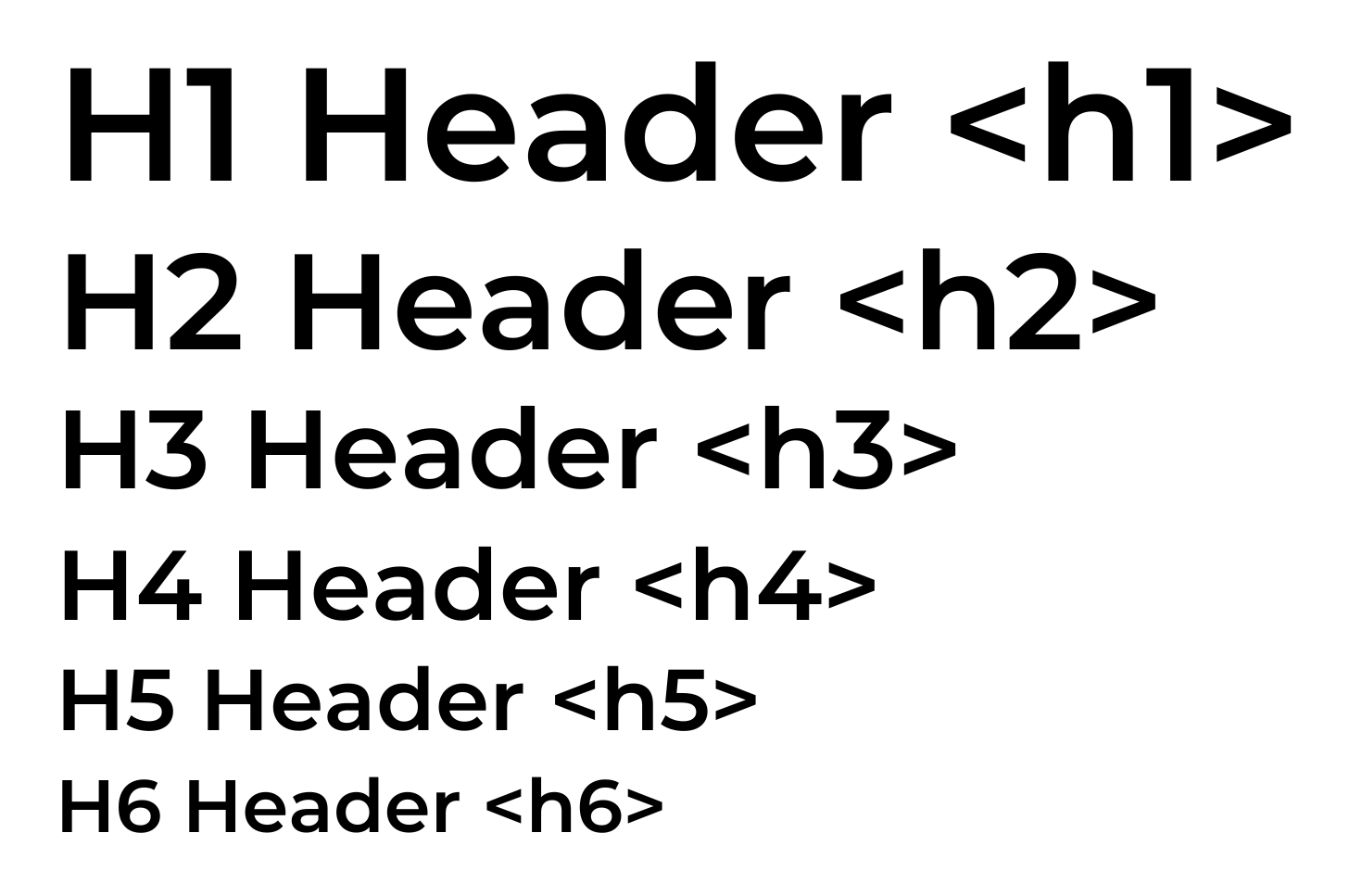What are Headers?
Headers are an essential element in web design and content creation, serving as the titles and subtitles that structure and organize web page content. They are marked by HTML tags – H1, H2, H3, and so on, up to H6. The ‘H’ in these tags stands for ‘Heading’, and the number denotes the level of the heading.

The H1 tag is used for the main title of the page, making it the most prominent header, and is crucial for both user navigation and search engine optimization (SEO). Subsequent headers, H2 to H6, are used for subheadings, providing a hierarchical structure to the content. This hierarchy helps in breaking down information into manageable sections, making it easier for users to scan and comprehend the content.
In addition to organizing content, headers also play a key role in SEO, as they help search engines understand the main topics and structure of a webpage, thus aiding in the page’s ranking for relevant searches. For websites, especially those in information-rich fields like B2B manufacturing, the effective use of headers is vital for both enhancing user experience and improving online visibility.
The Logical Structure of Headers
The logical structure of headers refers to the way headers (H1, H2, H3, etc.) are used on a webpage to organize and prioritize content in a hierarchical manner. Understanding the differences between H1, H2, H3, and so on is crucial for both readability and SEO. Here’s a breakdown:

H1: The Main Title
- Purpose: The H1 tag is used for the main title of the page and is the most important header in terms of SEO. It gives users and search engines a clear indication of the primary subject of the page.
- Usage: There should be only one H1 tag per page. This is typically the first thing a user sees and often matches or closely resembles the page title.
- Example: On a page about manufacturing processes, the H1 could be “Innovative Manufacturing Processes for the 21st Century”.
H2: Major Section Titles
- Purpose: H2 tags are used for major section headings. They break down the page’s content into main topics, acting as subheadings under the primary title.
- Usage: Use H2 tags for distinct sections within the page. These are less broad than the H1 but still cover significant topics.
- Example: Under the aforementioned H1, H2s could be “3D Printing in Manufacturing” or “Robotic Automation in Assembly Lines”.
H3: Subsections
- Purpose: H3 tags are used for subsections within an H2. They provide an additional layer of organization, breaking down each H2’s content into more specific topics.
- Usage: Whenever a major section (H2) can be divided into smaller parts, use H3 tags for these divisions.
- Example: Under an H2 titled “3D Printing in Manufacturing,” you might have H3s like “Materials for 3D Printing” and “3D Printing Techniques”.
H4, H5, H6: Further Subdivision
- Purpose and Usage: These headers are used for further subdivision of content, becoming more specific as the hierarchy descends. They are less common but can be useful in organizing very detailed or complex content.
- Example: An H4 might break down an H3 further, such as “Types of Metal Alloys for 3D Printing” under the “Materials for 3D Printing” H3.
Header Tag Guidelines
- Sequential Use: It’s important to use these headers in sequence. Avoid skipping levels (like jumping from H1 to H3) as this can confuse readers and search engines about the structure of your content.
- Consistency: Keep your header styles consistent throughout your website. This helps in maintaining a professional and coherent look.
- Balance: While it’s important to use headers for organization, avoid overusing them. Too many headers can make a page look cluttered and can overwhelm the reader.
By using headers in this logical structure, you create a clear and organized path through your content, making it easier for users to navigate and for search engines to understand and index your pages effectively. This structure is fundamental in web design and content creation, especially for sites like those of B2B manufacturers, where conveying complex information clearly is key.
Header Best Practices
Prioritize Clarity and Relevance
Your headers should act as clear signposts. For example, instead of a generic header like “Our Services,” use a more descriptive one like “Custom Metal Fabrication Services.” This specificity helps users and search engines alike to understand your content quickly.
Incorporate Keywords Strategically
Place relevant keywords in headers where they make natural sense. For example, if you are targeting the keyword “precision engineering,” a header might read, “Precision Engineering: Innovations in CNC Technology.” This integrates the keyword organically without feeling forced.
Maintain a Logical Structure
Adhere to a clear hierarchy. Start with an H1 tag for the overall page title, then use H2 tags for main section titles, and H3s for sub-sections within those. For instance, under an H2 titled “Advanced Materials for Manufacturing,” you might have H3s like “Titanium Alloys” and “High-Temperature Composites.”
Make Them Engaging
Craft headers that are both informative and engaging. Use action verbs, questions, or brief compelling statements. For example, “Discover Cutting-Edge Manufacturing Processes” is more engaging than just “Manufacturing Processes.”
Ensure Mobile-Friendliness
Headers should be responsive and easily readable on all devices. Ensure your font sizes scale appropriately for smaller screens, so headers don’t dominate the view or become too small to read.
Utilize Header Variations
Differentiate various header levels with distinct styles. For instance, H2s could be bold and colored, whereas H3s might be italicized. This variation helps in maintaining visual interest and guiding the reader’s eye through the content.
Keep Them Short and Sweet
Aim for concise headers that convey the essence of the following content. For example, instead of a lengthy header like “The Comprehensive Guide to Modern Manufacturing Techniques and Innovations,” opt for a shorter version like “Modern Manufacturing: Techniques & Innovations.”
Test and Iterate
Utilize A/B testing to experiment with different header styles and formats to see what works best. Monitor metrics such as time on page and bounce rate to gauge how your headers are influencing user engagement and make adjustments based on these insights.
The Importance of Headers on a Website
- Enhancing User Experience: The primary function of headers is to improve readability. When dealing with intricate manufacturing details, headers can break down information into manageable chunks, making it easier for visitors to find and comprehend the information they need.
- SEO Optimization: Headers are critical for SEO. Search engines use them to understand the content structure and main topics of a webpage. Well-optimized headers with relevant keywords help in ranking higher in search results, making it easier for potential clients to find your website.
- Guiding the Reader’s Journey: Headers act as signposts, guiding readers through your content. In the B2B manufacturing context, where the sales cycle can be long and detailed, headers help keep readers engaged by leading them through technical descriptions, product benefits, and application scenarios.
- Highlighting Key Information: For busy professionals who may not have the time to read through extensive content, headers provide a way to quickly scan and pinpoint crucial information, such as specific manufacturing capabilities or technical specifications.
- Improving Accessibility: Headers also play a vital role in making web content accessible to people with disabilities. Screen readers use headers to navigate content, making it crucial that headers accurately represent the structure and key points of your content.
Unlock Optimal SEO Impact: Let’s Optimize Your Headers
Ready to transform your website’s headers into a powerful tool for SEO and user engagement? Reach out today to learn more about creating a comprehensive strategy that leverages the full potential of well-structured headers, driving your B2B manufacturing site to the top of search results.
Related Articles
Search Engine Optimization (SEO)
One often overlooked but powerful digital marketing strategy is the effective use of internal and external linking within their SEO strategy.
Search Engine Optimization (SEO)
Understanding site hierarchy—how your website's pages are structured and interconnected—can significantly impact both user experience and your site's SEO performance.
Search Engine Optimization (SEO)
One of the key components to achieving an online presence is through keywords. In this blog post, we'll explore keyword insights tailored specifically for the B2B manufacturing sector.



